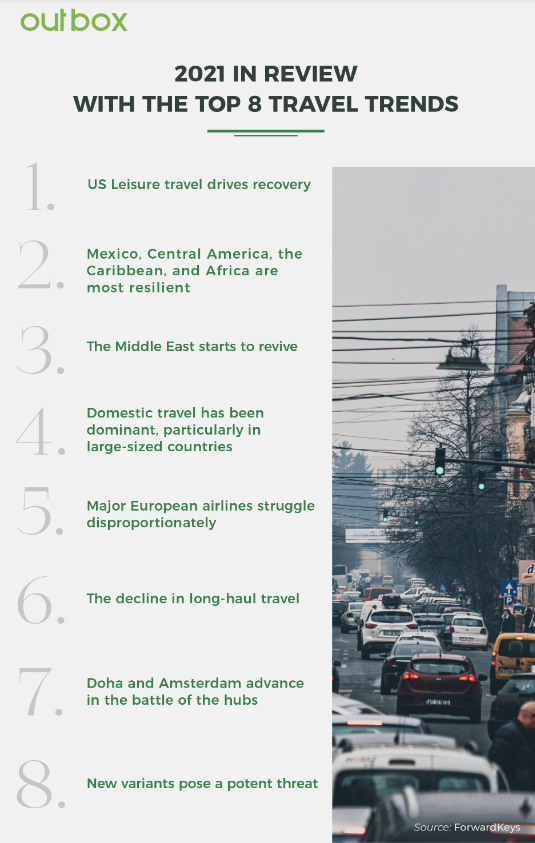With 2021 ending, many are wondering what to expect of the New Year as the Omicron variant breaks news headlines around the world. The team of analysts at ForwardKeys, step back to examine some of the key learnings as they review 2021 from the perspective of a travel professional and highlight the top trends.
 1. US Leisure travel drives recovery
1. US Leisure travel drives recovery
A comparison of the world’s top destination cities, before the pandemic in 2019, and throughout 2021, illustrates the strong trend towards leisure travel leading to the recovery. Several major cities have been pushed down or out of the top 20 rankings, whereas major leisure destinations, particularly for US holidaymakers, have climbed high.
While Dubai remains at the top of the list (it is a major leisure destination as well as a substantial travel and commerce hub), the most notable rises include, Miami, from 18th to 5th, Madrid from 16th to 10th and new into the list. The two highest risers, Cancun, and Miami are both major leisure destinations popular with US holidaymakers. Most of the new entrants lower down the list are also leading leisure destinations, popular with European holidaymakers.
2. Mexico, Central America, the Caribbean, and Africa are the most resilient
A review of worldwide travel in 2021, broken down by region, reveals the extent to which international travel was paralysed. Overall, international air travel was just over a quarter (26%) of its pre-pandemic level. The Asia Pacific region reached just 8%; whereas Europe achieved 30%, Africa & the Middle East 36% and the Americas 40%.
A comparison of travel between the first and second halves of the year (H1 and H2) shows that global international travel more than doubled from 16% of pre-pandemic levels to 36%. However, the recovery was extremely uneven.
Within the regions, some countries were much more resilient to the impact of COVID-19 on travel than others. The stand-out destinations which best maintained their visitor numbers were Central America, particularly El Salvador and Belize, and the Caribbean – all holiday hotspots for US tourists. Many of them managed to record visitation rates above 60% of 2019 levels throughout the year. The same degree of travel resilience was true of around two dozen countries in Africa. However, their level of resilience is a little less noteworthy because many of them have economies that are much less dependent on tourism.
3. The Middle East starts to revive
Travel to various Middle East destinations and also exceeded the 60% benchmark in H2. Most notably, travel to Turkey climbed from 33% in H1 to 67% in H2 of pre-pandemic levels and travel to Egypt grew from 37% to 72%. Dubai held its position as the top city destination, and Doha overtook Dubai as an air transit hub.
4. Domestic travel has been dominant, particularly in large-sized countries
While many countries have been able to impose severe restrictions on international travel, citing the need to keep their populations safe, imposing equally stiff constraints on one’s populations is politically more challenging. Consequently, there has been a relative rise in domestic travel, particularly in geographically large countries such as Brazil, China, Russia, and the USA, where it is possible to fly for a few hours without crossing the border.
In China, domestic travel volumes returned to pre-pandemic levels as early as September 2020; however, they fell back in January and again in August, owing to a resurgence in cases of COVID19. In Brazil, Russia, the US and China, domestic travel rose respectively to 148%, 128%, 87% and 76% of pre-pandemic levels in the second half of 2021, compared to 50%, 28%, 39% and 1% for international travel.
5. Major European airlines struggle disproportionately
Largely due to the trend towards domestic travel in large countries, airlines in those markets have managed to weather the COVID-19 storm better than carriers whose business has been more oriented towards short-haul international travel. This is illustrated by an analysis of the top 20 airlines in 2021 compared to 2019. The major European carriers have all fallen or are out of the ranking; and they have been replaced by airlines that have substantial business in China and the US, which have been better able to maintain capacity.
For example, Ryanair and EasyJet, the two largest European carriers, have fallen from 5th and 8th position respectively, to 7th and 16th. Lufthansa, British Airways and Air France, Europe’s largest legacy carriers, have fallen out of the top 20 list, as have Emirates and Air Canada. They have been replaced by Shenzhen, JetBlue, Spirit, Hainan, and Xiamen.
6. The decline in long-haul travel
A comparison of international travel within the major world regions, intra-regional travel, and between world regions, extra-regional (or long-haul) travel, reveals that there has been a shift away from long-haul travel during the pandemic. In 2019 the ratio of intra-regional to extra-regional travel was 56%:44%; but in 2021, that had changed to 62%:38%. The pattern has also changed, with a greater proportion of people within Europe and the Americas travelling intra-regionally rather than the long haul.
The trend can be explained by a combination of several factors, including the effective closure of one region of the world, Asia Pacific, the increased cost, and difficulty of travelling long haul during the pandemic and frequently changing pandemic travel regulations, which deter people from booking long-haul travel, as it is typically booked and planned with much longer lead times.
7. Doha and Amsterdam advance in the battle of the hubs
In the battle of the hubs, Doha overtook Dubai to become the preeminent hub airport in the Middle East, connecting air traffic between South Asia, the Middle East, North America, and Sub-Saharan Africa. In Europe, Amsterdam closed the gap on Frankfurt for intra-European transits and connections with North America.
Pre-pandemic, the top ten list of global hub airports was headed by Dubai with a 7.7% market share of intercontinental flight connections. It was followed by Frankfurt, Amsterdam, Doha, Istanbul, Paris, Hong Kong, Munich, London, and Abu Dhabi. In 2021, it was headed by Amsterdam, with an 8.3% share of intercontinental flight connections. Analysis of monthly traffic in 2021 shows that Amsterdam briefly overtook Frankfurt in September and October, but it fell back in November. In the same month, Dubai recovered its lead over Doha for the first time since February.
8. New variants pose a potent threat
A chart plotting the recovery in air travel shows relatively steady growth from the first quarter of 2021 when traffic was less than 20% of 2019 levels to the fourth quarter when it had climbed to over 50%. However, there were two setbacks: the first began during the week of 12 March, when the growth in weekly bookings turned from +11% to -10%, as the Delta variant began to sweep around the world. The second began in the last week of October when weekly bookings reached their highest point, 64% of the same week in 2019. Bookings have been slowing down ever since; and in late November, they were down to 54% of 2019 levels, which was closely correlated with a fresh rise in COVID-19 cases since late October.
Source: ForwardKeys

 1. US Leisure travel drives recovery
1. US Leisure travel drives recovery

